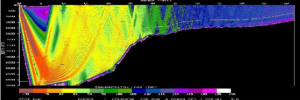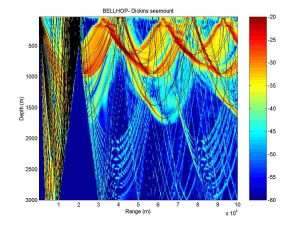So, I missed my target of one post a week. I’ve been busy learning about acoustic propagation deep ocean environments, the Soar cognitive architecture, and about other projects going on at SoarTech. Last week my first SoarTech proposal was submitted for review. This was a Navy SBIR for Oceanography Tactics Training. Doing research on acoustic propagation reminded me of the optics class I took as an undergrad. I found it very interesting that the speed of sound changes so drastically with temperature and depth. This introduces issues when looking at propagation over large distances (many kilometers). Sound no longer propagates in a uniform manner from a point source, but curves up and down as the sound speed profile / index of refraction changes. Additionally you get interesting interference and reflection patterns near continental slopes.
I found a good book on the topic, Computational Ocean Acoustics (2nd Edition), which describes the math and theory of propagation and various simulation models such as ray tracing. The book is nice because it defines all the mathematical symbols in the text. This is something that is lacking in many of the academic papers I read. I also found the Acoustics Toolbox, a simulator package for acoustics research and associated pages with links to algorithm descriptions and other acoustics research sites.

My proposal for N182-119 described a simulation-based training system I called ShadowZone, because why not? It combines some of SoarTech’s existing web-based training products with a new Unity-based simulation and assessment environment for demonstrating acoustic propagation under various ocean conditions. It was a great two week crash course for me in acoustics and got me back into my Scientist™️ hat (you know, reading, planning, proposal writing), which was super fun and refreshing!